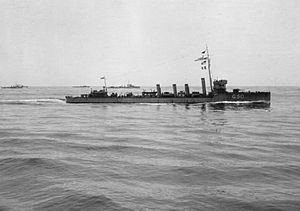- Marksman class destroyer
-

HMS IthurielClass overview Name: Marksman-class Operators:  Royal Navy
Royal NavyBuilt: 1914–1916 In commission: 1915–1936 Completed: 7 General characteristics Type: Destroyer leader Displacement: 1,600 long tons (1,600 t) Length: 321 ft (98 m) Beam: 31 ft 9 in (9.68 m) Draught: 11 ft (3.4 m) Propulsion: Yarrow type boilers (White-Forster in Lightfoot)
Parsons steam turbines (Brown-Curtis in Marksman, Nimrod)
3 shafts
36,000 shpSpeed: 24 knots (28 mph; 44 km/h) Range: 510 tons oil, ? Complement: 106–116 Armament: • 4 × QF 4-inch (101.6 mm) Mark IV guns, single mounting P Mk. XI
• 2 × twin 21-inch (530 mm) torpedo tubes
• 2 × single 2-pounder (40-mm) "pom-pom" Mk. II, single mounting HA Mk. IIThe Marksman class (sometimes known as Lightfoot class[1]) were a class of flotilla leaders built for the Royal Navy. Two each were ordered in the naval programmes of 1913–14 and 1914–15 with a further three being ordered under the Emergency War Programme and all saw service during World War I.
Like other British flotilla leader designs, these ships were significantly larger than the typical destroyers of the day, in order to accommodate the flotilla staff ("Captain (D)" in Royal Navy parlance) and the necessary additional signalling gear. All ships had four funnels, the foremost being taller (although it was later cut down post-war in Nimrod and Abdiel). They were armed with four QF 4 inch guns. The guns were carried one each on the forecastle, between the first three funnels and on a bandstand on the quarterdeck. Abdiel and Gabriel were later fitted as fast minelayers, for which purposes they landed the after 4 inch gun and their torpedo tubes and were screened by canvas panels from the fourth funnel to the stern to give shelter to 60 to 70 mines. Nimrod and Kempenfelt later received QF 12 pdr (3 inch / 76 mm) 18 cwt[citation needed] anti aircraft guns in place of one of the QF 2 pdr.
Following the war-time trend to install director firing in ever-smaller vessels as resources permitted, Lightfoot was selected to serve as a test-bed for the Royal Navy's new training-only director firing system for flotilla leaders and destroyers in March, 1917. By August, results obtained were favourable enough that it was decided to equip fully 203 other leaders and destroyers of "L" class and later.[2]
Contents
Ships
Two were ordered under the 1913–14 Programme.
- J. Samuel White, Cowes, laid down 9 June 1914, launched 28 May 1915, completed 29 May 1915, sold for breaking up 9 May 1921.
Two ordered under the 1914–15 Programme.
- Hawthorn Leslie and Company, Newcastle upon Tyne, laid down 20 July 1914, launched 28 April 1915, completed 18 November 1915, sold for breaking up 8 November 1921.
- William Denny and Brothers Limited, Dumbarton, laid down 9 October 1914, launched 12 April 1915, completed 25 August 1915, sold for breaking up 5 November 1926.
Three ordered in November 1914 under the War Emergency Programme.
- Abdiel — built by Cammell Laird, Birkenhead, laid down 6 May 1915, launched 12 October 1915, completed 26 March 1915, sold for breaking up July 1936
- edit] See also
References
- ^ Lightfoot Class Flotilla Leaders
- ^ The Technical History and Index: Fire Control in HM Ships, 1919, p. 12.
- Destroyers of the Royal Navy, 1893–1981, Maurice Cocker, 1983, Ian Allan ISBN 0-7110-1075-7
- Jane's Fighting Ships, 1919, Jane's Publishing
- The Technical History and Index: Fire Control in HM Ships. No. 3, Part 23. Technical History Branch, Admiralty, 1919, CB 1515 (23).
External links
Categories:- Marksman class destroyers
- Destroyer classes
Wikimedia Foundation. 2010.
